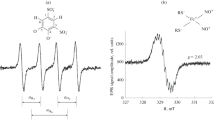Abstract
This study was performed with the objective of assessing the mechanical response of the myocardium to different levels of cerium and delineation of the mechanism underlying the mediation of the functional changes. Rat ventricular papillary muscle was used as the experimental model. Isolated papillary muscles were exposed to different concentrations of CeCl3 and the force of contraction was measured using a force transducer. Experiments have revealed that the negative inotropic response to CeCl3 was proportional to its concentration. The inotropic changes were found to be completely reversible at concentrations ≤5µM, and partially reversible at higher concentrations. Neutralization of cerium-induced inotropic changes by the superoxide anion scavenger superoxide dismutase (SOD) at concentrations ≤5 µM indicates that the mechanical changes are mediated by reactive oxygen species. At higher concentrations of Ce3+, SOD partially reversed the contractile changes. The beneficial effect of SOD was seen only if the muscles were pretreated with the scavenger prior to the addition of cerium chloride.
Similar content being viewed by others
References
S. Hirano and K. T. Suzuki, Exposure, metabolism and toxicity of rare earths and related compounds, Environ. Health Perspect. 104, 85–95 (1996).
M. S. Valiathan, C. C. Kartha, J. T. Eapen, H. S. Dang, and C. M. Sunta, A geochemical basis for endomyocardial fibrosis, Cardiovasc. Res. 23, 647–648 (1984).
M. S. Valiathan, and C. C. Kartha, Endomyocardial fibrosisthe possible connection with myocardial levels of magnesium and cerium, Int. J. Cardiol. 20, 1–5 (1990).
G. Vocaturo, F. Colombo, M. Zanoni, F. Rodi, E. Sabbioni, and R. Pretra, Human exposure to heavy metals. Rare earth pneumoconiosis in occupational workers, Chest 83, 780–783 (1983).
J. T. Eapen, C. C. Kartha, and M. S. Valiathan, Cerium levels are elevated in the serum of patients with endomyocardial fibrosis, Biol. Trace Element Res. 59, 41–44 (1997).
W. G. Sanborn, and G. A. Langer, Specific uncoupling of excitation and contraction in mammalian cardiac tissue by lanthanum, J. Gen. Physiol. 5, 191–217 (1970).
G. A. Langer, S. D. Serena, and L. M. Nudd, Cation exchange in heart cell culture: correlation with effects on contractile force, J. Mol. Cell. Cardiol. 6, 149–161 (1974).
R. Preeta, and R. R. Nair, Stimulation of cardiac fibroblast proliferation by ceriuma-superoxide anion mediated response, J. Mol. Cell. Cardiol. 31, 1573–1580 (1999).
M. S. Wolin and F. L. Belloni, Superoxide anion selectively attenuates catecholamine induced contractile tension in rabbit aorta, Am. J. Physiol. 249, H1127–H1133 (1985).
R. R. Nair, R. Preeta, S. George, and I. K. Adiga, Variation in mitogenic response of cardiac and pulmonary fibroblasts to cerium, Biol. Trace Element Res. in Press.
M. Labedzka, H. Gulyas, N. Schmidt, and G. Gercken, Toxicity of metallic ions and oxides to rabbit alveolar macrophages. Environ. Res. 48, 255–274 (1989).
A. Seidel, In-vitro effects of CeCl3 and LaCl3 on macrophages. in Endomyocardial Fibrosis. M. S. Valiathan, K. Somers, and C. C. Kartha, eds., University Press, New Delhi, pp. 254–265 (1993).
Halliwell, The antioxidant paradox, Lancet 355, 1179–1180 (2000).
Author information
Authors and Affiliations
Rights and permissions
About this article
Cite this article
Manju, L., Remani, K. & Nair, R.R. Negative inotropic response to cerium in ventricular papillary muscle is mediated by reactive oxygen species. Biol Trace Elem Res 96, 203–208 (2003). https://doi.org/10.1385/BTER:96:1-3:203
Received:
Revised:
Accepted:
Issue Date:
DOI: https://doi.org/10.1385/BTER:96:1-3:203




